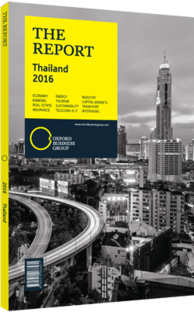Rapid expansion for e-commerce in Thailand
E-commerce in Thailand is growing rapidly and is set to become a main driver of internet development. To a great extent, 4G is responsible for the transformation, as it will be bringing faster connectivity to a large, nationwide pool of consumers. Estimates place e-commerce spending growth over the next five years at 18.2%. The subsector is already quite large. The Electronic Transaction Development Agency estimates e-commerce totalled BT2.1trn ($63.2bn) in 2015. The largest piece was generated by the accommodation and food services sector, at BT658.9bn ($19.8bn), followed by manufacturing at BT350.29bn ($10.5bn), and retail and wholesale at BT325.08bn ($9.8bn). Interestingly, demand for e-commerce services are coming not only from Bangkok but also from the provinces, such as Nonthaburi and Chonburi.
The growth is beginning to draw interest from international companies. Transcosmo, a Japanese e-commerce company, formed a joint venture in 2015 with Ookbee, a Thai online bookstore. Additionally, Alibaba’s YTO has been in talks with Thailand’s Crown Tech Advance to discuss local logistics.
Developments
Companies in the space are fast developing and evolving with user interests and demand. Line, which has 33m users in Thailand, is expanding its offerings in the country, taking its chat product beyond messaging. The company says that the enhancements will allow users to undertake tasks, such as booking taxis and paying for items. Payment apps have also become a growing trend, though for the time being cash-on-delivery remains the norm.
There have been some setbacks in the subsector, but they seem to be company specific or the result of intense local competition. In late 2015 Groupon closed in seven countries, including Thailand and the Philippines. In part, this was a result of the company’s model not working well over the long term, as “deal fatigue” kicked in. It was also the result of the rise of strong local competition, according to TechInAsia.
In early 2016 it was reported that Rakuten – a Japanese e-commerce company – would be leaving the Thai e-commerce market by selling its 67% stake in Tarad.com – a Thai online shopping site – which it acquired in 2009 for $35m. The move was the result of a repositioning from business-to-business and business-to-customer, to customer-to-customer.
Top 10
In 2015 the top e-commerce site it Thailand was Lazada, a regional online mall and the largest online retailer in South-east Asia. It has been in the country for four years and had more than 20m page visits in January 2015. The company said that business has been growing quickly as more people get used to the technology and social media becomes more popular in Thailand. It added that it is evolving its business and beginning to use the country as a hub for regional marketing and other activities. To that end, it has moved its app development to Thailand.
WeLoveShopping is the second-most-popular e-commerce site and the company expects online sales to go from about 1.4% of Thai retail to 8% by 2020. To maximise that growth, the company plans to build up its presence in Thailand and expand regionally. It’s goal is to become a leading e-commerce player in ASEAN and it plans to invest BT5.3bn ($159.5m) to expand into Vietnam, Indonesia, Myanmar, Cambodia, Malaysia and Singapore. In 2015 the company restructured its business by adding a payments system to its marketplace.
The other top 10 e-commerce sites in Thailand are Tarad, followed by Zalora, Ensogo, Cdiscount, J.I.B., Central.co.th, iTrueMart and Munkong Gadget.
Logistics
In early 2016 DHL launched its e-commerce platform in Thailand, bringing domestic end-to-end delivery to the market. DHL said that Thailand is key to its e-commerce strategy and expects the market to triple by 2020. It will be offering next-day delivery to urban areas in the country; two to three-day delivery will be possible in other areas in Thailand.
You have reached the limit of premium articles you can view for free.
Choose from the options below to purchase print or digital editions of our Reports. You can also purchase a website subscription giving you unlimited access to all of our Reports online for 12 months.
If you have already purchased this Report or have a website subscription, please login to continue.

